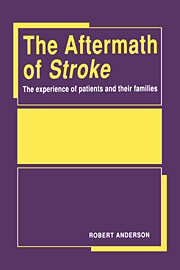Book contents
- Frontmatter
- Contents
- Acknowledgements
- Chapter 1 Stroke: An introduction to the problem
- Chapter 2 The Greenwich stroke study
- Chapter 3 Coming into medical care: the first month after stroke
- Chapter 4 Hospital care and rehabilitation
- Chapter 5 Survival, physical disability and health
- Chapter 6 Support in the community
- Chapter 7 The effects of stroke on social, family and personal life
- Chapter 8 Caring and coping with stroke
- Chapter 9 Resources for coping with stroke
- Appendix: Measurement and scoring of variables
- References
- Index
Chapter 3 - Coming into medical care: the first month after stroke
Published online by Cambridge University Press: 07 October 2011
- Frontmatter
- Contents
- Acknowledgements
- Chapter 1 Stroke: An introduction to the problem
- Chapter 2 The Greenwich stroke study
- Chapter 3 Coming into medical care: the first month after stroke
- Chapter 4 Hospital care and rehabilitation
- Chapter 5 Survival, physical disability and health
- Chapter 6 Support in the community
- Chapter 7 The effects of stroke on social, family and personal life
- Chapter 8 Caring and coping with stroke
- Chapter 9 Resources for coping with stroke
- Appendix: Measurement and scoring of variables
- References
- Index
Summary
The onset of the stroke
Following the onset of symptoms the patient or a carer must make decisions about whether to seek medical help and, if so, whether to contact the general practitioner or go direct to hospital. The typical scenario is thought to involve the sudden loss of movement or speech leading to rapid consultation with the general practitioner, who decides whether the patient should be cared for at home or referred to hospital. In general, this appears not to have been the experience of patients in Greenwich. Two points should be noted when comparing these patients with other series: first, since it is a study of survivors many of the patients with poor prognostic signs for survival of the stroke – for example, unconsciousness (Oxbury et al., 1975; Aho et al., 1980) – are excluded; secondly, no other study has been done in London, and in Greenwich no patient is more than 8 kilometres from a district general hospital.
At the time of onset of the stroke 83% of patients were at home, 6% were in, or attending, the hospital, and 11% were at work or elsewhere – a distribution similar to that in other studies of all strokes (e.g. Wade, 1984). However, it was apparent in the responses of patients and supporters to the question ‘What happened?’ that the definition of time of onset was often difficult.
- Type
- Chapter
- Information
- The Aftermath of StrokeThe Experience of Patients and their Families, pp. 32 - 58Publisher: Cambridge University PressPrint publication year: 1992



